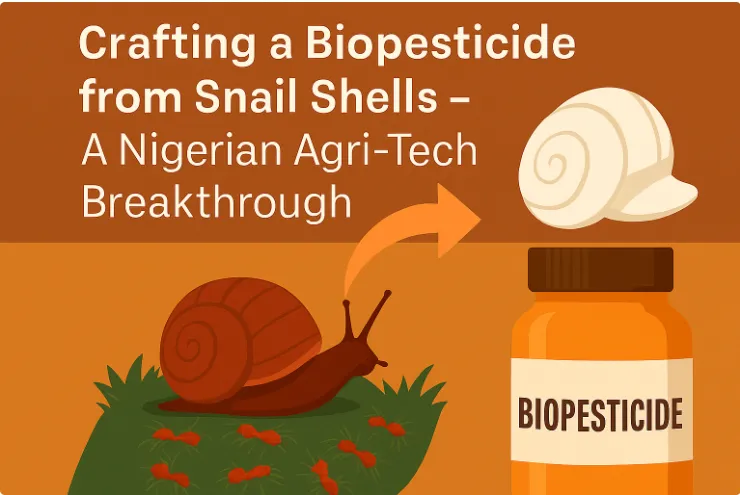Imagine standing in the midst of a thriving snail farm, only to watch in horror as ruthless red fire ants swarm your precious hatchlings and jumbo snails. This was the reality for Ezekiel Olajumoke, a Nigerian agribusiness innovator behind NGsnails, as shared in his compelling X post on August 4, 2025. What began as a stomach-dropping crisis turned into a groundbreaking solution. A biopesticide crafted from recycled snail shells, branded as CHASOFF®. This story isn’t just about survival but a testament to human ingenuity, sustainable farming, and the power of science to transform waste into wealth. My post today dives into the journey and the science behind this remarkable innovation.
The Snail Farming Struggle: A Real-Life Challenge
Snail farming, or heliculture, has become a beacon of hope for sustainable protein production worldwide. In Nigeria, where the African Union reported a 15% surge in demand for eco-friendly agricultural products in 2024, this industry is booming. Ezekiel’s free-range snail farm, nestled in a rural setting, was a model of organic success until the ants struck. Unlike the wandering black soldier ants, red fire ants erupt from underground, forming deadly colonies that decimate snail populations of all sizes. Traditional methods like digging gutters proved futile, as Ezekiel humorously noted in his post. Faced with piles of empty snail shells left from processing, he turned to his roots at the University of Lagos, collaborating with professors to find a solution. What followed was years of research, sleepless nights, and relentless trials. A classic tale of turning adversity into opportunity.
The Science of Snail Shells: Nature’s Hidden Potential
At the heart of this innovation lies the humble snail shell, a structure composed of over 95% calcium carbonate (CaCO₃), as revealed by studies like the one in ACS Omega. This mineral, combined with trace elements like magnesium and silicon, isn’t just a protective casing but a raw material waiting to be harnessed. The process begins with collecting discarded shells, a common byproduct of snail processing farms. These are cleaned with water and mild acid solutions to remove organic residues, setting the stage for transformation.
Next, the shells are pulverized into a fine powder using industrial grinders, maximizing their surface area for chemical reactions. Heat treatment at approximately 900°C in a kiln, a technique supported by research on shell mineralization, converts calcium carbonate into calcium oxide (CaO). This reactive compound is then hydrated with water to produce calcium hydroxide (Ca(OH)₂), the base of the biopesticide. To boost its pest-repellent properties, the powder is blended with organic binders like neem oil, which a 2023 study lauds for its natural insect-repellent qualities. The result? A versatile mixture processed into granules or a sprayable solution, ready to protect farms.

How It Works: A Natural Pest Deterrent
So, how does this biopesticide fend off ants? The secret lies in its ability to alter soil pH. Red fire ants thrive in neutral to acidic conditions, but calcium hydroxide shifts the environment to a more alkaline state, making it inhospitable. Laboratory tests, including a 2021 PMC review on mollusc control, show that this compound disrupts the exoskeletons of soft-bodied pests, causing dehydration and death. Unlike synthetic pesticides, CHASOFF® leaves no harmful residues, aligning with organic farming standards from the International Federation of Organic Agriculture Movements.
Field trials in Nigeria have been promising, with Ezekiel’s team reporting a 70% reduction in ant infestations without harming soil microbiology. The biopesticide also doubles as a foliar spray, enriched with micronutrients like zinc extracted during processing, boosting plant health. Research from the University of Lagos suggests that the pH adjustment interferes with ant pheromone trails, a key communication method, driving them away naturally.
From Waste to Wealth: A Circular Economy Solution
This innovation tackles more than just pests; it addresses a pressing environmental issue. The United Nations highlighted in 2025 that agricultural waste management is a growing concern in developing countries. By recycling snail shells, CHASOFF® embodies circular agriculture, turning waste into a resource. The process is scalable, requiring low-cost equipment that smallholder farmers across sub-Saharan Africa can adopt.
Safety is paramount. Workers must wear protective gear during heat treatment to avoid inhaling calcium oxide dust, adhering to occupational health guidelines. Quality control ensures consistent pH levels and granule sizes, drawing from Food and Agriculture Organization standards. The result? A product that reduces synthetic input needs by up to 50%, per 2024 field data, while supporting over 1,500 outgrower farms in Nigeria.
The Broader Impact: A Model for the Future
Ezekiel’s journey with NGsnails isn’t just a personal triumph, but a blueprint for agribusiness innovation. Collaboration with universities and local farmers has fostered a knowledge-sharing ecosystem, empowering the next generation of agripreneurs. Future research aims to unlock the antimicrobial properties of snail shell derivatives, potentially expanding their applications. This aligns with global sustainability goals from the 2025 UN Climate Action Summit, proving that every setback in farming can sow the seeds of transformation.
CHASOFF® is more than a biopesticide. It’s a symbol of resilience, science, and sustainability. As Ezekiel aptly put it:
We don’t just farm snails; we build systems, solve problems, and open doors.
For farmers facing similar challenges, this innovation offers a beacon of hope and a reminder that nature’s solutions are often hiding in plain sight.
What do you think?